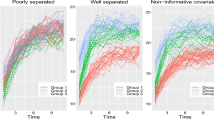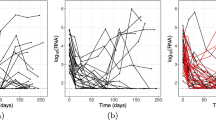Abstract
Nonlinear random coefficient models (NRCMs) for continuous longitudinal data are often used for examining individual behaviors that display nonlinear patterns of development (or growth) over time in measured variables. As an extension of this model, this study considers the finite mixture of NRCMs that combine features of NRCMs with the idea of finite mixture (or latent class) models. The efficacy of this model is that it allows the integration of intrinsically nonlinear functions where the data come from a mixture of two or more unobserved subpopulations, thus allowing the simultaneous investigation of intra-individual (within-person) variability, inter-individual (between-person) variability, and subpopulation heterogeneity. Effectiveness of this model to work under real data analytic conditions was examined by executing a Monte Carlo simulation study. The simulation study was carried out using an R routine specifically developed for the purpose of this study. The R routine used maximum likelihood with the expectation–maximization algorithm. The design of the study mimicked the output obtained from running a two-class mixture model on task completion data.



Similar content being viewed by others
Notes
The data were obtained from Robert Cudeck who acquired them from Scott Chaiken of the Armstrong Laboratory, Brooks Air Force Base. A more detailed explanation of the origins of the data can be found in Cudeck (1996).
\(\hbox {MD}=\Delta =\sqrt{( {\varvec{\upalpha } }_1 -{\varvec{\upalpha } }_2 {)}'{\varvec{\Phi } }^{-1}({\varvec{\upalpha } }_1 -{\varvec{\upalpha } }_2 )},\) where \({\varvec{\upalpha } }_1 \) and \({\varvec{\upalpha } }_2 \) denote the mean vector of fixed / population effects or class 1 and class 2, respectively, and \({\varvec{\Phi } }\) denotes the variance—covariance matrix of random effects.
Results from a preliminary simulation study in which MD values were much small (i.e., less distributional separation) can be found at http://www.cehd.umn.edu/edpsych/people/Faculty/Kohli.html. These results showed poor convergence to a proper solution and large bias of model parameters—particularly the variance–covariance components of the linear–linear NRMM.
We ran a separate simulation study where we empirically generated the starting values. The results from that study can be found on the following webpage: http://www.cehd.umn.edu/edpsych/people/Faculty/Kohli.html
References
Aitkin, M., & Rubin, D. B. (1985). Estimation and hypothesis testing in finite mixture models. Journal of the Royal Statistical Society Series D (Methodological), 47, 67–75.
Arminger, G., Stein, P., & Wittenberg, J. (1999). Mixtures of conditional mean and covariance structure models. Psychometrika, 64, 475–494.
Blozis, S. A. (2004). Structured latent curve models for the study of change in multivariate repeated measures data. Psychological Methods, 9, 334–353.
Blozis, S. A., & Cudeck, R. (1999). Linear mixed-effects models with latent variable covariates. Journal of Educational and Behavioral Statistics, 24, 245–270.
Boos, D., & Brownie, C. (1991). Mixture models for continuous data in dose-response studies when some animals are unaffected by treatment. Biometrics, 47, 1489–1504.
Codd, C. L., & Cudeck, R. (2014). Nonlinear random-effects mixture models for repeated measures. Psychometrika, 79, 60–83.
Crowder, M., & Hand, D. (1990). Analysis of repeated measures. London: Chapman and Hall.
Cudeck, R. (1996). Mixed-effects models in the study of individual differences with repeated measures data. Multivariate Behavioral Research, 31, 371–403.
Cudeck, R., & du Toit, S. H. C. (2002). A nonlinear form of quadratic regression with interpretable parameters. Multivariate Behavioral Research, 37, 501–519.
Cudeck, R., & Harring, J. R. (2007). The analysis of nonlinear patterns of change with random coefficient models. Annual Review of Psychology, 58, 615–637.
Cudeck, R., & Harring, J. R. (2010). Developing a random coefficient model for nonlinear repeated measures data. In S.-M. Chow, E. Ferrer, & F. Hsieh (Eds.), Statistical methods for modeling human dynamics: An interdisciplinary dialogue. New York: Routledge.
Cudeck, R., & Klebe, K. J. (2002). Multiphase mixed-effects models for repeated measures data. Psychological Methods, 7, 41–63.
Davidian, M., & Giltinan, D. M. (1995). Nonlinear models for repeated measurement data. London: Chapman & Hall.
du Toit, S. H. C., & Cudeck, R. (2009). Estimation of the nonlinear random coefficient model when some random effects are separable. Psychometrika, 74, 65–82.
Everitt, B. S., & Hand, D. J. (1981). Finite mixture distributions. London: Chapman & Hall.
Fitzmaurice, G. M., Laird, N. M., & Ware, J. H. (2011). Applied longitudinal analysis (2nd ed.). New York: Wiley.
Frühwirth-Schnatter, S. (2006). Finite mixture and Markov switching models. New York: Springer.
Grimm, K. J., & Ram, N. (2009). Nonlinear growth models in M plus and SAS. Structural Equation Modeling: A Multidisciplinary Journal, 16, 676–701.
Gruen, B., & Leisch, F. (2007). Fitting finite mixtures of generalized linear regressions in R. Computational Statistics & Data Analysis, 51, 5247–5252.
Hall, D. B., & Wang, L. (2005). Two-component mixtures of generalized linear mixed effects models for cluster correlated data. Statistical Modelling, 5, 21–37.
Hancock, G. R., & Samuelsen, K. M. (Eds.). (2008). Advances in latent variable mixture models. Charlotte, NC: Information Age Publishing Inc.
Harring, J. R. (2009). A nonlinear mixed effects model for latent variables. Journal of Educational and Behavioral Statistics, 34, 293–318.
Harring, J. R. (2012). Finite mixtures of nonlinear mixed effects models. In J. R. Harring & G. R. Hancock (Eds.), Advances in longitudinal methods in the social and behavioral sciences (pp. 159–192). Charlotte, NC: Information Age Publishing Inc.
Harring, J. R., Cudeck, R., & du Toit, S. H. C. (2006). Fitting partially nonlinear random coefficient models as SEMs. Multivariate Behavioral Research, 41, 579–596.
Hartford, A., & Davidian, M. (2000). Consequences of misspecifying assumptions in nonlinear mixed effects models. Computational Statistics & Data Analysis, 34, 139–164.
Harwell, M. R. (1997). Analyzing the results of Monte Carlo studies in item response theory. Educational and Psychological Measurement, 57, 266–278.
Harwell, M. R., Stone, C. A., Hsu, T., & Kirisci, L. (1996). Monte Carlo studies in item response theory. Applied Psychological Measurement, 20, 101–125.
Hipp, J. R., & Bauer, D. J. (2006). Local solutions in the estimation of growth mixture models. Psychological Methods, 11, 36–53.
Jennrich, R. I., & Schluchter, M. D. (1986). Unbalanced repeated measures models with structured covariance matrices. Biometrics, 42, 805–820.
Kohli, N., & Harring, J. R. (2013). Modeling growth in latent variables using a piecewise function. Multivariate Behavioral Research, 48, 370–397.
Kohli, N., Harring, J. R., & Hancock, G. R. (2013). Piecewise linear–linear latent growth mixture models with unknown knots. Educational and Psychological Measurement, 73, 935–955.
Laird, N. M., & Ware, J. H. (1982). Random-effects models for longitudinal data. Biometrics, 38, 963–974.
Liu, M., & Hancock, G. R. (2014). Unrestricted mixture models for class identification in growth mixture modeling. Educational and Psychological Measurement, 74, 557–584.
Luo, X., Boos, D. D., & Tamura, R. N. (2004). Score tests for dose effect in the presence of non-responders. Statistics in Medicine, 23, 3581–3591.
McLachlan, G., & Peel, D. (2000). Finite mixture models. New York: Wiley.
Muthén, B. O. (2001). Latent variable mixture modeling. In G. A. Marcoulides & R. E. Schumacker (Eds.), New developments and techniques in structural equation modeling (pp. 1–33). Mahwah, NJ: Lawrence Erlbaum Associates.
Muthén, B. O. (2002). Beyond SEM: General latent variable modeling. Behaviormetrika, 29, 81–117.
Muthén, B. O. (2004). Latent variable analysis: Growth mixture modeling and related techniques. In D. Kaplan (Ed.), Handbook of quantitative methodology for the social sciences (pp. 345–368). Newbury Park, CA: Sage.
Muthén, B. O., & Shedden, K. (1999). Finite mixture modeling with mixture outcomes using the EM algorithm. Biometrics, 55, 463–469.
Nagin, D. S. (2005). Group-based modeling of development. Cambridge, MA: Harvard University Press.
Nylund, K. L., Asparouhov, T., & Muthén, B. (2007). Deciding on the number of classes in latent class analysis and growth mixture modeling: A Monte Carlo simulation study. Structural Equation Modeling: A Multidisciplinary Journal, 14, 535–569.
Pavlic, M., Brand, R. J., & Cumming, S. R. (2001). Estimating probability of nonresponse to treatment using mixture distributions. Statistics in Medicine, 20, 1739–1753.
Pinheiro, J. C., & Bates, D. M. (2000). Mixed-effects models in S and S-PLUS. New York: Springer-Verlag.
Raudenbush, S. W., & Bryk, A. S. (2002). Hierarchical linear models (2nd ed.). Thousand Oaks: Sage Publications.
R Core Team (2013). R: A language and environment for statistical computing. Vienna, Austria: R Foundation for Statistical Computing.
Schwarz, G. (1978). Estimating the dimension of a model. Annals of Statistics, 6, 461–464.
Seber, G. A. F., & Wild, C. J. (1989). Nonlinear regression. New York: Wiley.
Singer, J. D., & Willett, J. B. (2003). Applied longitudinal data analysis: Modeling change and event occurrence. New York: Oxford University Press.
Smith, J. L., & Klebe, K. J. (1997, June). Design issues in learning experiments: A comparison between repeated measures ANOVA and a latent growth curve. Paper presented at the Annual Meeting of the Psychometric Society, Gatlinburg, TN.
Sokal, R. R., & Rohlf, F. J. (1995). Biometry: The principles and practice of statistics in biological research (3rd ed.). New York: W.H. Freeman.
Titterington, D., Smith, A., & Makov, U. (1985). Statistical analysis of finite mixture distributions. Chichester: Wiley.
Tueller, S. J., Drotar, S., & Lubke, G. H. (2011). Addressing the problem of switched class labels in latent variable mixture model simulation studies. Structural Equation Modeling, 18, 110–131.
Verbeke, G., & Lesaffre, E. (1996). A linear mixed-effects model with heterogeneity in the random effects population. Journal of the American Statistical Association, 91, 217–221.
Verbeke, G., & Molenberghs, G. (2000). Linear mixed models for longitudinal data. New York, NY: Springer-Verlag.
Vonesh, E. F. (2012). Generalized linear and nonlinear models for correlated data: Theory and applications using SAS. Cary, NC: SAS Institute.
Vonesh, E. F., & Carter, R. L. (1992). Mixed effects nonlinear regression for unbalanced repeated measures. Biometrics, 48, 1–17.
Wang, L., & McArdle, J. J. (2008). A Simulation study comparison of bayesian estimation with conventional methods for estimating unknown change points. Structural Equation Modeling: A Multidisciplinary Journal, 15, 52–74.
Wedel, M., & DeSarbo, W. S. (1995). A mixture likelihood approach for generalized linear models. Journal of Classification, 12, 21–55.
Xu, W., & Hedeker, D. (2001). A random-effects mixture model for classifying treatment response in longitudinal clinical trials. Journal of Biopharmaceutical Statistics, 11, 253–273.
Zopluoglu, C., Harring, J. R., & Kohli, N. (2014). FitPMM: An R routine to fit finite mixtures of piecewise mixed-effects models with unknown random knots. Applied Psychological Measurement, 38, 583–584.
Author information
Authors and Affiliations
Corresponding author
Rights and permissions
About this article
Cite this article
Kohli, N., Harring, J.R. & Zopluoglu, C. A Finite Mixture of Nonlinear Random Coefficient Models for Continuous Repeated Measures Data. Psychometrika 81, 851–880 (2016). https://doi.org/10.1007/s11336-015-9462-0
Received:
Published:
Issue Date:
DOI: https://doi.org/10.1007/s11336-015-9462-0




